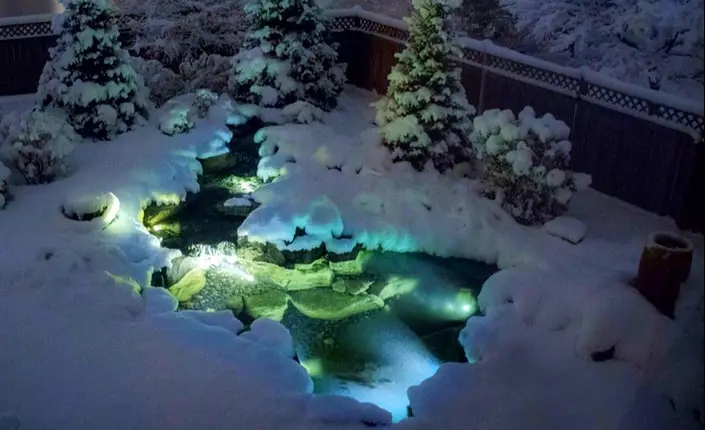
Winter is coming! For pond owners, that means it’s time to get your aquatic paradise ready for the chilly months ahead. Pond winterization doesn’t have to feel like a chore—these nine tips will make the process a breeze and ensure your pond is happy, healthy, and ready to shine come spring.
1. Say Goodbye to Leaf Litter
Think of your pond as a guest preparing for winter hibernation—it doesn’t need a messy bed! Scoop out fallen leaves, twigs, and any other debris. A pond net can act as your pond’s “blanket,” keeping more leaves from falling in as autumn winds down. Bonus: A clean pond means less work when spring rolls around!
2. Give Plants a Winter Haircut
Plants, like us, appreciate a little trim before the cold sets in. For hardy plants, cut them back to about an inch above their crowns. Tropical plants, on the other hand, need to head indoors for a cozy, frost-free vacation. Keeping your greenery tidy is a key part of successful pond winterization.
3. Switch Up Your Fish’s Diet
Picture this: your fish are slowing down as the water gets colder, and their bellies can’t handle heavy meals anymore. Help them out by switching to a wheat germ-based fish food when water temperatures drop below 50°F. When it hits 40°F, it’s time to stop feeding altogether—don’t worry, they’ll be just fine!
4. Keep the Water Flowing
During pond winterization, you’ll need to prevent the water from freezing completely, especially in colder regions. A trusty aerator or pond de-icer will do the trick, ensuring your fish can still breathe and your ecosystem stays balanced. Think of it as life support for your pond!
5. Show Some Love to Your Equipment
Your pump and filter work hard all year long, so now’s the time to make sure they’re ready for winter. Clean them out, inspect for any wear, and either adjust or shut them down based on your system. Pro tip: Store delicate equipment in a dry, frost-free spot to extend its lifespan.
6. Prep Your Fish for Winter Mode
As the water chills, your fish naturally slow down, entering a hibernation-like state called torpor. To keep them stress-free, make sure your pond water is clean and stable before winter hits. Clear water = happy, healthy fish!
7. Boost Your Pond with Beneficial Bacteria
Think of beneficial bacteria as your pond’s winter cleanup crew. Adding a dose of fall-friendly bacteria helps break down leftover organic gunk, keeping the water clear and reducing the workload for spring. It’s an easy, hands-off win for pond winterization!
8. Protect Your Water Features
Don’t let your fountains and waterfalls suffer in the cold. Drain the water lines, remove smaller features, and store them safely until spring. For larger ones, consider covering them to prevent ice damage. Your pond’s features will thank you!
9. Keep an Eye on Water Levels
Winter can sneakily lower your pond’s water level due to freezing and evaporation. Keep a close watch and top it off as needed. A well-hydrated pond is a happy pond, even in the dead of winter!
Why Pond Winterization Matters
Pond winterization isn’t just about surviving winter—it’s about thriving when spring arrives. By taking these steps now, you’ll avoid costly repairs, keep your fish and plants safe, and enjoy a crystal-clear pond when warmer weather returns. Plus, who doesn’t love a little peace of mind?
Ready to Master Pond Winterization?
Don’t wait until it’s too late to book your spot.
Contact Atlantis Water Gardens today or give us a call at 973-627-0515 to schedule your winter consultation. Let’s create the perfect pond for your outdoor space, so you’re ready to relax and enjoy it when the flowers bloom.
Discover more winter tips, tricks and information located on our learning hub at
Atlantis Water Gardens!
Check out these blogs:
How Do Seasonal Changes Affect Water Features?
Why Should New Jersey Homeowners Winterize Fountainscapes?
Why Are My New Jersey Koi Fish Hanging Around My Waterfall?
 Winter is coming! For pond owners, that means it’s time to get your aquatic paradise ready for the chilly months ahead. Pond winterization doesn’t have to feel like a chore—these nine tips will make the process a breeze and ensure your pond is happy, healthy, and ready to shine come spring.
Winter is coming! For pond owners, that means it’s time to get your aquatic paradise ready for the chilly months ahead. Pond winterization doesn’t have to feel like a chore—these nine tips will make the process a breeze and ensure your pond is happy, healthy, and ready to shine come spring.